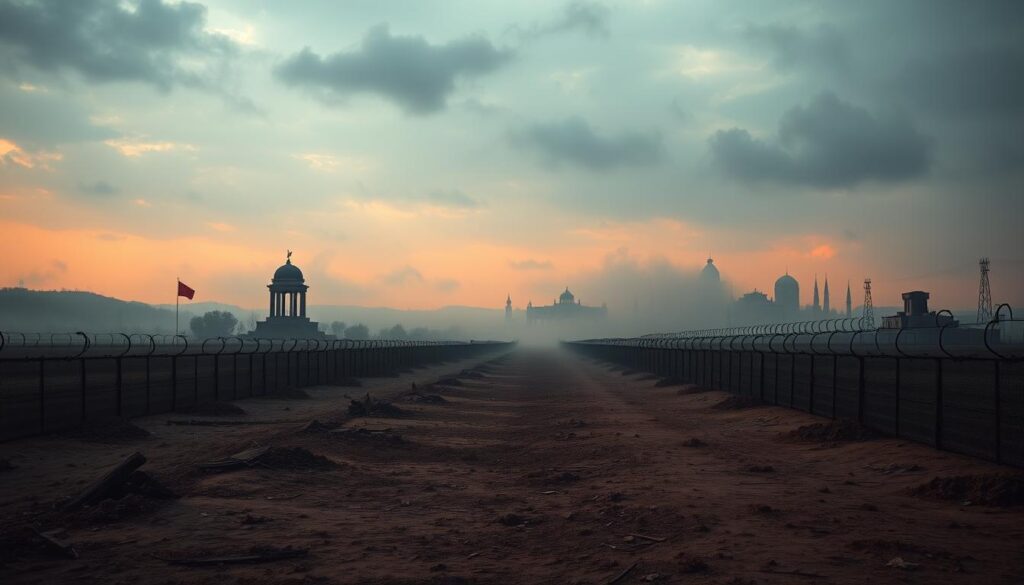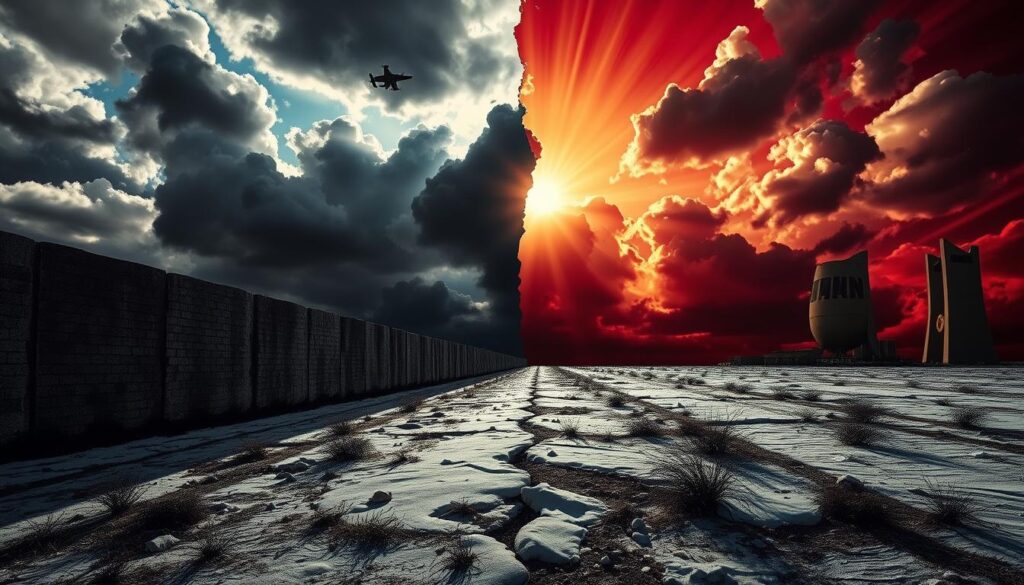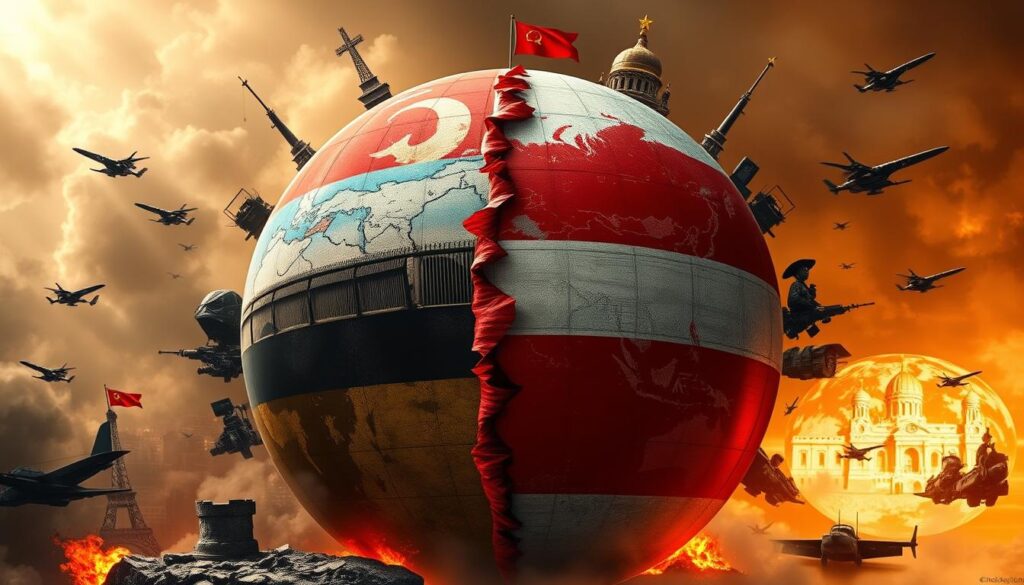Did you know the Cold War cost between $5 trillion and $10 trillion in today’s dollars? This long conflict between the United States and the Soviet Union changed global politics. It led to proxy wars and brought the world close to nuclear war.
Let’s dive into the Cold War’s origins, key events, and lasting effects. This chapter in history is crucial to understand.
Key Takeaways
- The Cold War was a global ideological and geopolitical rivalry between the capitalist United States and the communist Soviet Union from 1947 to 1991.
- The conflict was driven by competing visions for the post-World War II world order, with both superpowers seeking to expand their spheres of influence.
- Major events and crises of the Cold War included the Berlin Wall, the Cuban Missile Crisis, the Korean War, and the Vietnam War.
- The nuclear arms race between the US and USSR created a constant threat of “mutually assured destruction” and shaped global security policies.
- The Cold War ended with the collapse of the Soviet Union in 1991, marking the victory of the capitalist system and the United States as the sole global superpower.
Understanding the Cold War: An Overview
The Cold War was a long period of tension between the Soviet Union and the United States. It lasted from the end of World War II until the early 1990s. This conflict was fueled by a big difference in economic and political systems.
The Ideological Divide: Communism vs. Capitalism
The Soviet Union believed in a system where the government controls everything. They had a single-party system. On the other hand, the United States believed in a system where people and businesses make their own choices. They had a free market economy and many political parties.
This difference in beliefs affected more than just politics and economics. It also changed culture and society in many countries.
The Superpowers: United States and Soviet Union
After World War II, the Soviet Union and the United States became the two most powerful countries. They wanted to grow their influence and be seen as the top world leaders. The Soviet Union wanted to spread communism, while the United States wanted to stop it and promote capitalism.
This competition led to the creation of opposing alliances. It also caused Europe to be divided. Both sides raced to be the best in technology and military power.
| Characteristic | Soviet Union | United States |
|---|---|---|
| Political System | Communist, single-party rule | Democratic, multi-party system |
| Economic System | Centralized, state-controlled economy | Capitalist, free market economy |
| Global Influence | Expansion of communist ideology and Soviet sphere of influence | Containment of communism and promotion of capitalist model |
“The Cold War was a state of political and military tension between the United States and the Soviet Union and their respective allies, the Western Bloc and the Eastern Bloc.”
Origins and Catalysts of the Global Conflict
The Cold War was a long period of tension between the United States and the Soviet Union. It started after World War II. The iron curtain and the division of Europe were key events that led to the global conflict of the 20th century.
The Iron Curtain and the Division of Europe
After the war, the Soviet Union took control of Eastern Europe. They set up communist regimes in Poland, Czechoslovakia, and East Germany. This created a clear divide between the West, led by the United States, and the East, led by the Soviet Union.
The iron curtain across Europe symbolized this divide. It set the stage for the Berlin Wall, a physical barrier of this division.
The Truman Doctrine and the Policy of Containment
In 1947, the United States introduced the Truman Doctrine. It promised to support free peoples facing communist threats. This doctrine led to the US containment policy, aimed at stopping communism’s spread.
| Event | Significance |
|---|---|
| Establishment of the Iron Curtain | Symbolized the ideological and political division between the capitalist West and the communist East |
| Truman Doctrine | Pledged US support for free peoples resisting communist subjugation, leading to the policy of containment |
The iron curtain, the Berlin Wall, the Truman Doctrine, and the US containment policy were crucial. They shaped the early Cold War, leading to the global conflict of the decades to come.

“The United States has become the trustee of the power and principle of free society.” – Harry S. Truman, 1947
The Cold War (1947–1991): A Journey Through Key Events
The Cold War lasted over 40 years and was a major global conflict. It was filled with key moments that changed history. Events like the Cuban Missile Crisis and the fall of the Soviet Union were crucial.
The Cuban Missile Crisis in 1962 was a close call with nuclear war. The Soviet Union placed missiles in Cuba, causing a standoff with the U.S. A diplomatic deal saved the day, but it changed global security forever.
The Korean War happened from 1950 to 1953. It was a fight between North and South Korea, backed by different world powers. This war led to Korea being divided and a tense border.
The Vietnam War lasted from 1955 to 1975. It was a long and bloody fight between the U.S. and North Vietnam. The war ended with the U.S. leaving and Vietnam becoming one under communism, affecting the world and the U.S. greatly.
The collapse of the Soviet Union in 1991 ended the Cold War. The fall of the Berlin Wall in 1989 was a big sign of this change. It showed the end of the Iron Curtain.
The Cold War was a time of constant tension between the U.S. and the Soviet Union. Each event had its own challenges and effects on history. These moments have shaped our world today.

The Nuclear Arms Race: Threat of Mutually Assured Destruction
The Cold War saw a never-ending nuclear arms race between the U.S. and the Soviet Union. Both sides built huge numbers of nuclear weapons. This made the world very close to a huge nuclear war.
The idea of nuclear deterrence came up. It was to stop either side from starting a war by threatening them with total destruction.
The Cuban Missile Crisis: Brink of Nuclear War
The Cuban Missile Crisis in 1962 was a very scary time. The Soviet Union put nuclear missiles in Cuba, just 90 miles from the U.S. This made the world very close to nuclear war.
For 13 days, the U.S. and the Soviet Union were in a very tense standoff. Both sides eventually decided not to start a nuclear war.
“The Cuban Missile Crisis was the moment when the Cold War came closest to turning into a hot war.” – John F. Kennedy
This crisis showed how fragile the world was during the nuclear arms race. It showed the need for good diplomacy and ways to solve conflicts without war.
The Cuban Missile Crisis and the nuclear arms race still affect the world today. The lessons from the past remind us of the dangers of nuclear weapons. They also remind us of the importance of working together and finding ways to reduce nuclear threats.
Proxy Wars and Spheres of Influence
The Cold War era saw a unique kind of global conflict called proxy wars. The United States and the Soviet Union fought by backing different sides in regional disputes. This way, they avoided direct battles with each other. The Korean War and the Vietnam Conflict are key examples of these proxy wars.
The Korean War and the Domino Theory
The Korean War started in 1950. North Korea, supported by the Soviet Union, attacked South Korea, backed by the United States. This conflict was about who could control more areas and stop communism from spreading.
The United States worried about communism in Asia. So, they helped South Korea, leading to a long and bloody war.
The Vietnam War and Spheres of Influence
The Vietnam War lasted from 1955 to 1975. The United States supported South Vietnam to stop communism in Southeast Asia. The Soviet Union and China helped North Vietnam instead.
This war was a big part of the Cold War. Both sides wanted to grow their influence and limit the other’s.
Proxy wars had big effects, not just for the countries involved but for the world’s balance of power. The lessons from these wars still influence how countries fight and interact today.
Conclusion: Lessons from the Cold War Era
The Cold War era has ended, leaving us with a deep understanding of global politics. The fall of communism, shown by the Soviet Union’s collapse, highlights the strength of reform and democracy’s lasting appeal. Mikhail Gorbachev’s efforts in glasnost and perestroika led to big changes. These changes ended the Warsaw Pact and grew NATO.
The Cold War’s legacy teaches us valuable lessons and warns us of dangers. The nuclear arms race shows the risks of unchecked tensions. Yet, the world’s ability to change and work together shows a path to a better future.
Looking back, we see the value of open talks, transparency, and peace. The USSR’s fall and the Cold War’s end bring new global challenges. We must face these with wisdom, empathy, and a focus on peace and progress.

